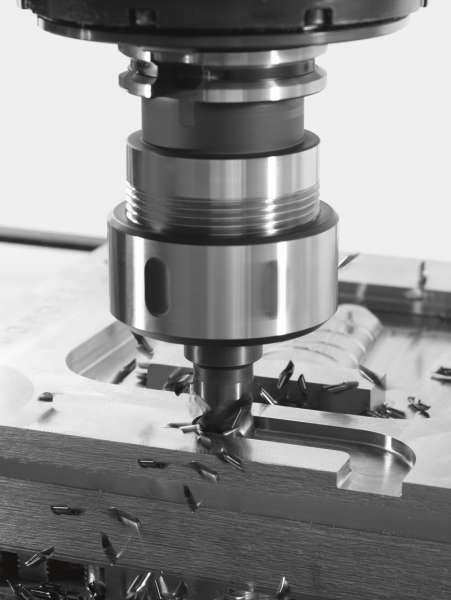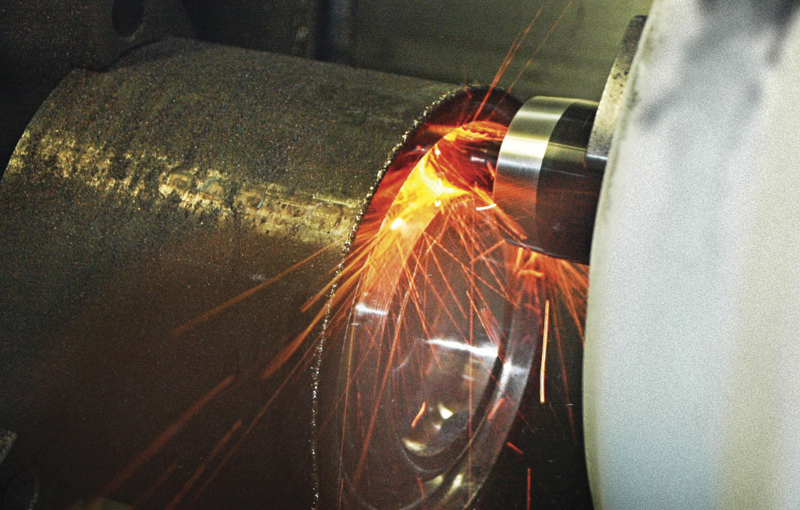by Mary Scianna
Cutting super alloys requires skill, experience and industry know-how
Exotic alloys, commonly referred to as super alloys, are often the materials of choice for many manufacturers because they offer excellent properties for machining components for aerospace, energy and resources: they offer strength and hardness retention at high temperatures and are highly resistant to corrosion. They are, however, as many know, demanding to machine. Shop Metalworking Technology asked cutting tool suppliers about the best way to cut some of these materials, such as chromium-molybdenum steel, Inconel (a family of high strength nickel, chromium and iron alloys) and titanium. Here’s their advice.
1. Plan before starting a job
It seems like an obvious statement to make, but suppliers stress it’s important to plan before you begin to machine an exotic alloy.
“We work on component solutions with university research centres and our key customers,” say Dirk Masur, aerospace component manager, based in Walter’s global headquarters in Tubingen, Germany. ‘It’s not only tooling, but also a combination of tooling processes and solutions. We look at new machining strategies that when combined with our innovative tool developments, will help to achieve long tool life.”
 With Inconel and Titanium for example, it’s important to understand the material you plan to machine so you can optimize cutting tools and processes, says Brian Mac Neil, milling products and application specialist for Sandvik Coromant, Mississauga, ON,
With Inconel and Titanium for example, it’s important to understand the material you plan to machine so you can optimize cutting tools and processes, says Brian Mac Neil, milling products and application specialist for Sandvik Coromant, Mississauga, ON,
“Customers who are new to quoting and cutting these types of materials need to focus on getting the best possible start to the job. Customers tend to use tools, inserts and fixtures they have lying around the shop. They program in the same way they would program for easier metals and then get poor results. That’s usually when we get called; people often blame the tooling company for producing an inadequate tool, but it’s usually because customers haven’t properly planned to machine these materials.”
Manufacturers must also take into account that since these materials are more difficult to machine you’re dealing with slower cutting speeds, says Dave Vetrecin, holemaking product manager for Iscar Tools, Oakville, ON. “Whether you’re machining Inconel, Titanium or Chromoly, all of the materials are treated the same way when it comes to machining them because they’re materials that have low cutting speeds. That’s because the main purpose of these types of materials are to work well in high heat and high strength areas such as jet engines.”
To effectively cut high tensile exotic materials requires machining know-how, the right tools and the right machine,
says McNeil. For example, you need to consider the spindle on your machine.
“Use the strongest spindle possible. These materials have high tensile strength and tend to push the tool away from the cutting zone. You also need through-spindle coolant and tools with the most volume and pressure you can achieve because these materials are designed to resist heat, which gets redirected back to the insert. Some of these materials also cause chemical reactions at the cutting zone and also smearing. Recutting of chips not removed from the cutting zone can damage inserts.”
In holemaking, Randy McEachern, product and application specialist for holemaking and tooling systems at Sandvik Coromant in Canada, says manufacturers should consider batch sizes and select tools with proper grades and geometries designed specifically for the material group.
“Thin walled components can be especially difficult to machine and will deflect due to feed force. Work hardening of hole surfaces affects subsequent operations and will have a negative affect on tool life.”
He cites a Sandvik Coromant solid carbide drill geometry, R846, as an example. Developed for heat resistant super alloys, the drill geometry features a large back taper and a small circular land to allow for free cutting action and for minimal work hardening.
“The convex edge maximizes peripheral corner strength against notch wear, reducing the feed force and improving chip formation. This is critical for effective chip evacuation. Of course, high pressure coolant, up to 70 bar, will also benefit chip evacuation and the entire
drilling process. We also recommend an emulsion coolant with increased concentration to a minimum 13 per cent for good results in drilling.”
2. Consider your machining strategy
When it comes to machiningcsuper alloys, suppliers suggest different machining strategies and practices to maximize tool life and cutting performance.
For instance, Bill Radtke, manager of Walter Tools Competence Center for the Americas, and colleague Dirk Masur, say concentric or spiral milling is a good option for machining titanium in roughing applications. The idea is to make “soft” spiral
cuts so you achieve soft tool engagement going in and going out, allowing for high material removal rates in a secure process.
“With our new grade for our indexable tool WSM 45X, we can achieve up to 100 per cent more tool life or 50 per cent higher cutting speeds in roughing applications for titanium milling. M3255 is a tangential helical milling cutter and insert with four cutting edges. We achieved more than 400 cm3/min of material removal on titanium with vc=65 m/min with a D80 mill by 70 min tool live in a side milling application,” explains Masur.
For milling applications, Vetrecin suggests high speed machining and plunge milling.
 “We typically suggest high speed machining or what’s called peel milling. In any type of machining process, you want to control the heat and with high speed machining, you take shallow cuts, so the depth of cut is large and the width of the cut is shallow and this minimizes work hardening.”
“We typically suggest high speed machining or what’s called peel milling. In any type of machining process, you want to control the heat and with high speed machining, you take shallow cuts, so the depth of cut is large and the width of the cut is shallow and this minimizes work hardening.”
There are many techniques to help overcome the challenges of machining super alloys, adds MacNeil. “Problems that occur slowly in simple materials occur immediately in difficult ones. There are many techniques we suggest and one in milling we suggest is trochoidal milling. It uses a low arc of engagement when slot milling. This reduces the heat in the cutting zone, but it allows users to increase feed rates. Sometimes this is a slower process, but it’s very secure and doesn’t typically destroy tools.”
For semi-finishing and finishing of titanium in milling applications, Radtke and Masur recommend a waterline strategy. This strategy is especially effective for milling thins walls, such as milling of rib sections for aerospace components. In waterline milling, either side of the thin wall feature is milled to pre-determined depths (varied depths of cuts) in non-overlapping passes.
Walter has developed a new tool that allows manufacturers to achieve semi-finishing and finishing in titanium in one combination tool with the waterline strategy.
“We’ve developed a new milling cutter, Ti 50, designed with a carbide shank with a solid carbide ConeFit tip for finishing up to 31.75 mm (1.25 in.) in diameter. The tool allows for semi-finishing and finishing in one step and can reduce machining time by 50 per cent. It’s designed for titanium machining and the design eliminates sharp edges or witness lines, which are stress points that impact tool performance and tool wear,” explains Masur.
Vetrecin recommends plunge milling. “The cutting forces are pushed axially into the spindle, and because of that, the cutting forces are at the bottom of the tool and it helps to achieve higher metal removal rates. We’ve put a special geometry on the insert for plunging. Typically, you would use the side of the cutter on face or end mills but now we’re using the bottom of the insert, which provides an advantage because it helps with stability of the cutting process. This is especially important in aerospace, where you typically have long reach applications.”
3. Use best practices.
The most important advice from suppliers is that manufacturers should use best machining practices.
“Simple things like entry to the part, how interruptions are approached and the arc of engagement of the cutting tool can reduce tool life drastically if they’re ignored,” says Mac Neil.
In solid carbide drilling, McEachern says manufacturers should plan and implement reconditioning of drills for best productivity. He cites the company’s CoroDrill 880 indexable insert drill as an example. “These drills have an assortment of grades and geometries, such as -LM and grade H13A for titanium and GC4344/1044. Grades such as LM GC1144 and MS GC2044 have sharp cutting edges with a touch PVD coating, making them good performers in titanium and other HRSA materials. Indexable insert drills often offer the best economy in your hole making process.”
Tool engagement is important, say Radtke and Masur.
“Always ensure that the tool is maintained at the same width of cut at all times and don’t change the cutting forces. If you go with a small amount of 1 or 2 mm depth of cut with a 25 mm tool in high dynamic milling strategy, you can increase the feed rate and the speed and it remains secure because cutting forces never change and this ensures longer tool life,” explains Masur.
Use tools that accept high pressure coolant, advises Vetrecin.
“If you can run faster it gives you a huge productivity advantage over your competitors. So you need to have high pressure spindles for milling and drilling. With our turning tools, you can point coolant at the cutting edge. The additional cost of adding a high pressure unit is outweighed by the production savings because you run parts quicker, which frees up the spindle for more jobs.” SMT
